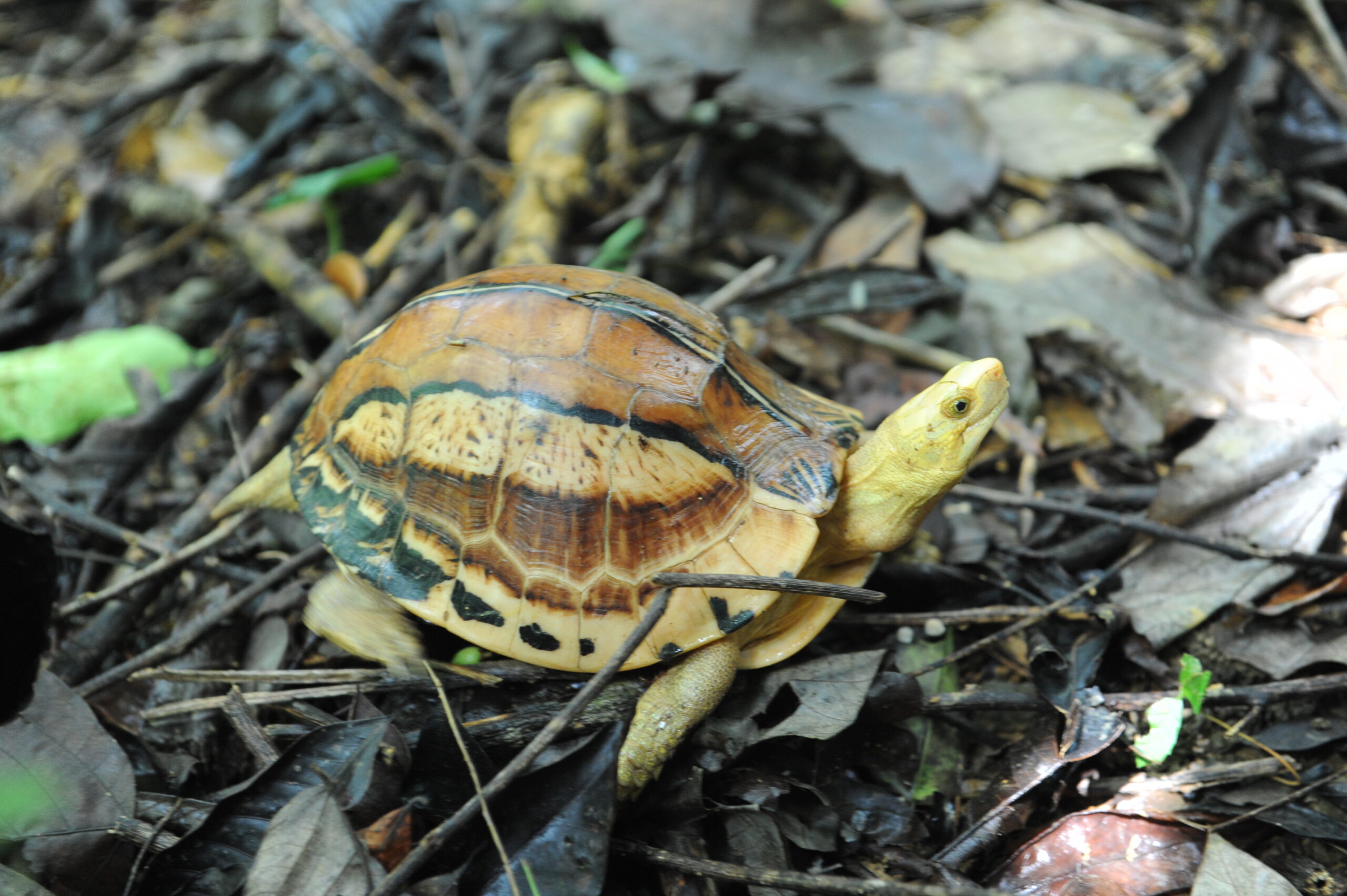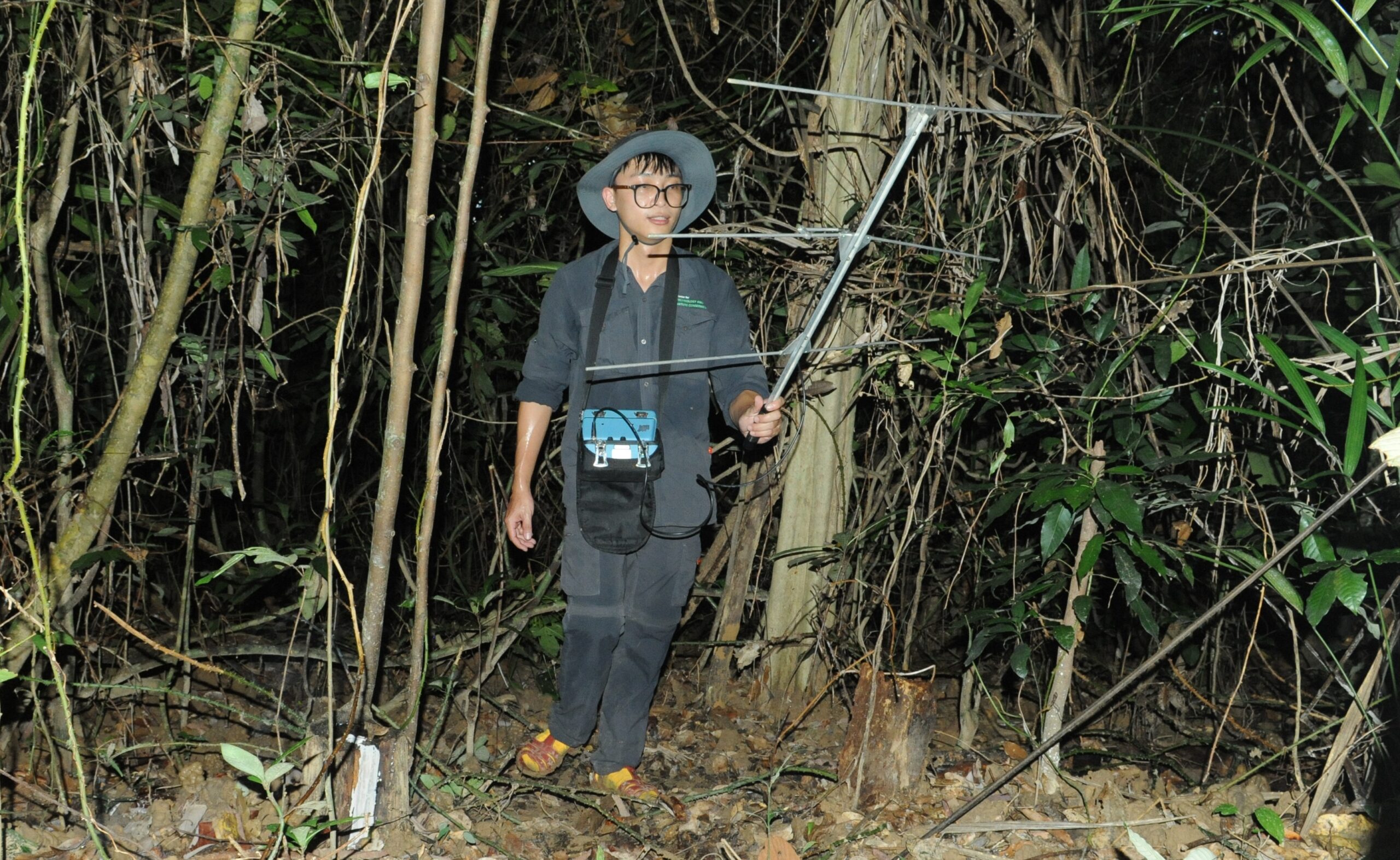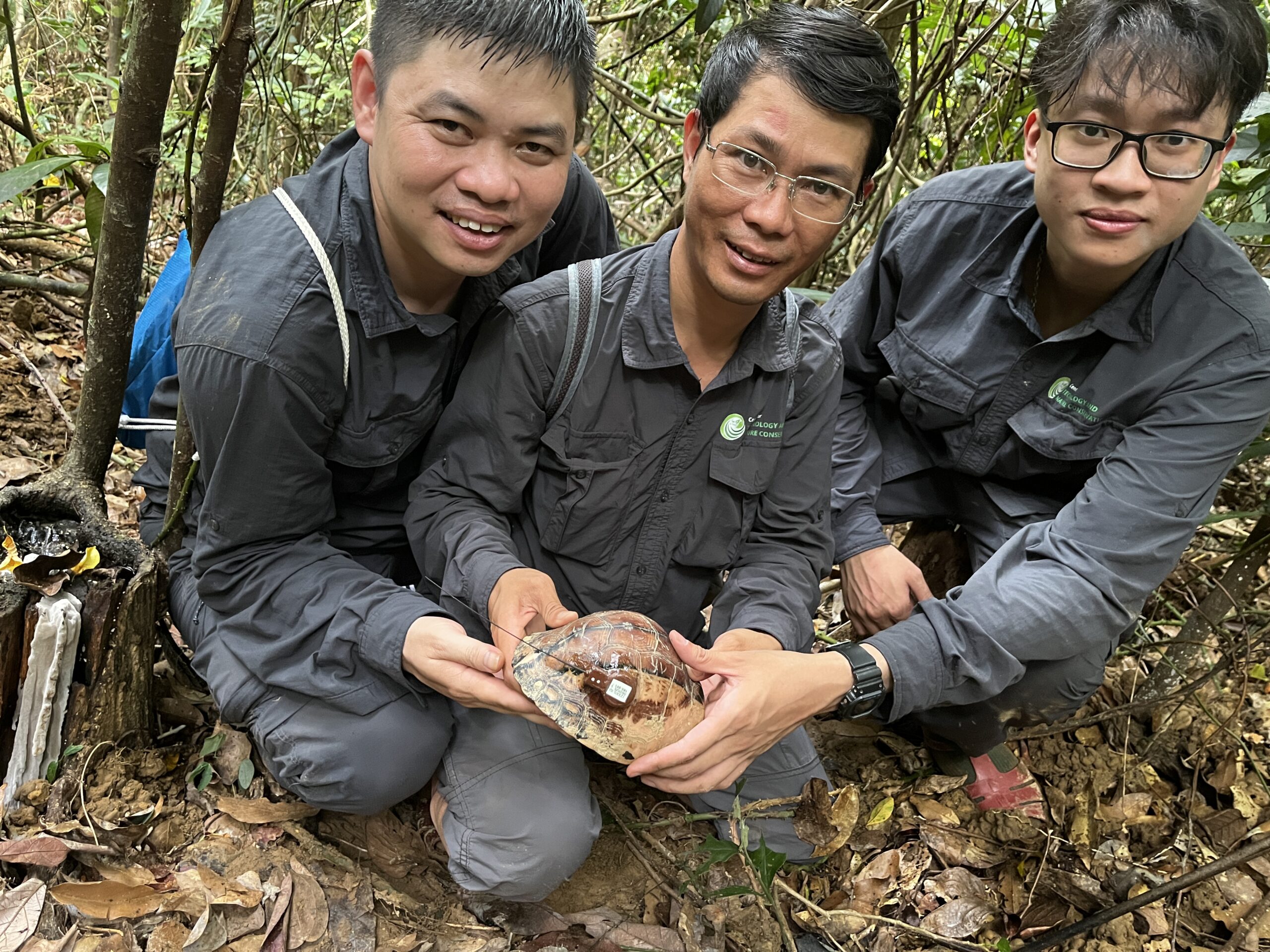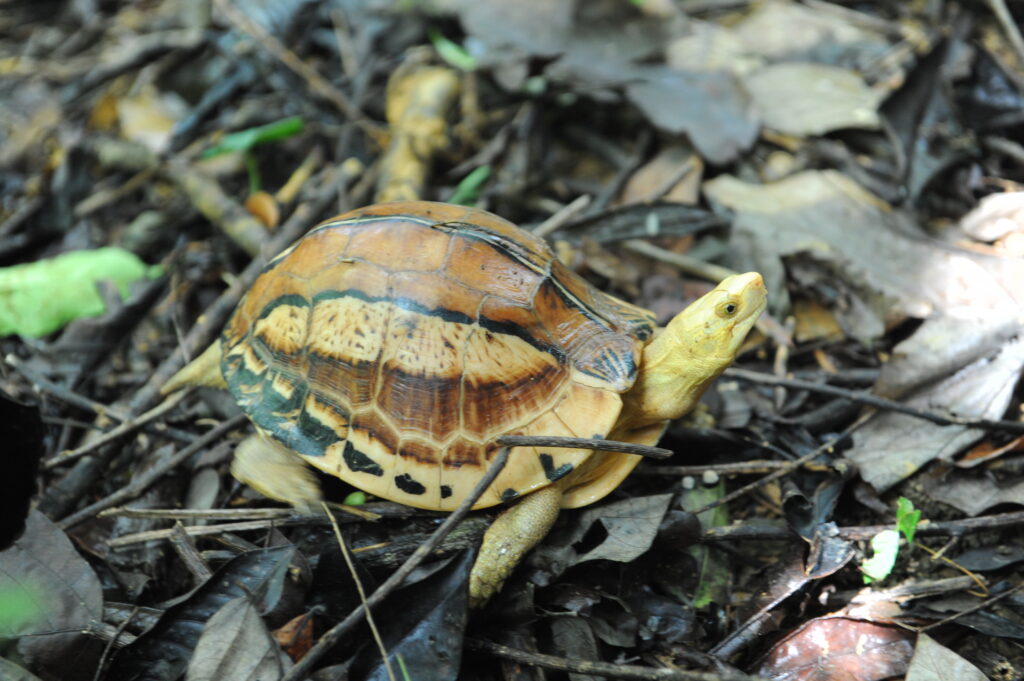TPO – The Southern Viet Nam Box Turtle—a species endemic to Vietnam and one of the world’s most beautiful turtles—is facing the threat of extinction due to relentless hunting and severe habitat degradation.
The Journey to Find the “Golden-Shelled Treasure” in the Lang Biang Forest
Early morning mist shrouded the old-growth forests of the Lang Biang Plateau (Lam Dong). Amidst the damp and silent expanse of the great forest, the soft rustle of dry leaves broke the silence under the research team’s footsteps. After months of trekking through streams and dense jungles, they finally saw what the global scientific community had awaited for decades: a Southern Viet Nam Box Turtle, a species previously known to the world only through descriptions in old reports.
“In that moment, my heart felt like it stopped,” recalls researcher Ly Tri from the University of Science, Ho Chi Minh City, reminiscing about the survey from July 2010 to January 2011. “Under the decaying leaves, the golden shell shone like a drop of sunlight in the forest, leaving anyone who witnessed it in awe.”
That discovery, along with seven other individuals, marked a milestone: the first time the Southern Viet Nam Box Turtle was ever recorded in the wild, although scientific documents had mentioned it since 1998.
Compared to many other turtle species recorded by French scientists since the 1900s, this species is considered a “latecomer,” being the last to be discovered among Vietnam’s box turtles.

Previously, the Southern Viet Nam Box Turtle was grouped under the general name of the Vietnamese box turtle. After morphological and genetic analyses, this group was split into three distinct species: the Northern Vietnamese box turtle, distributed from Northern Vietnam to Quang Tri; the Central Vietnamese box turtle, distributed from Quang Tri to the former boundary of Phu Yen (now part of Dak Lak); and the Southern Viet Nam Box Turtle, found only in Dak Lak and Khanh Hoa.
According to expert Phung Ngoc Khanh, Director of the Center for Technology and Nature Conservation (CTNC), the late discovery of this special turtle was not because it recently appeared, but due to a combination of reasons.
First is its narrow endemic range. The Southern Viet Nam Box Turtle lives only in a few small forest patches in Dak Lak (formerly Phu Yen province) and Khanh Hoa, and nowhere else in the world. This makes the chances of encountering them in the wild extremely rare.

Additionally, this turtle possesses excellent camouflage—its shell’s patterns and colors blend perfectly with dry leaves, forest floor debris, and the dim light under the canopy—making it very difficult to spot even for experienced researchers. For decades, it remained “hidden” from scientific eyes, only revealing itself in the second decade of the 21st century.
However, the rarity and exceptional beauty of the Southern Viet Nam Box Turtle became a “double-edged sword,” quickly making it a target for intense hunting for the domestic and international pet trade.
“More alarmingly, hunting dogs trained to find turtles are now their greatest threat. With their extremely sensitive sense of smell, dogs can track and locate turtles even when they are well-hidden, making their chances of survival in the wild even slimmer.”

With its narrow distribution, rapid decline, and intense hunting pressure, the Southern Viet Nam Box Turtle has been listed by the Turtle Conservation Coalition as one of the Top 40 most endangered turtles in the world. However, according to expert Phung Ngoc Khanh, it is regrettable that conservation efforts for this species did not receive adequate attention immediately after its discovery.
A recent survey by the Center for Technology and Nature Conservation (CTNC) revealed an alarming picture, with many wild turtles being illegally kept in local households. “Interviews with hunters and traders show that they always have a ready supply whenever a buyer places an order. This reflects a serious lack of legal awareness among the public regarding wildlife protection,” Mr. Khanh said.
A Home for the Turtles Must Be Protected
Concerned for the fate of the rare Southern Viet Nam Box Turtle, the Center for Technology and Nature Conservation (CTNC) has implemented several comprehensive solutions to protect it and other rare species in the region. One crucial step is the application of the SMART (Spatial Monitoring and Reporting Tool) system, which enhances the capacity for forest monitoring and controlling hunting and other violations.

In parallel, CTNC focuses on community outreach, considering it a sustainable foundation for conservation. Hundreds of posters and educational materials have been distributed to schools to foster a love for nature among students. Stories about wildlife protection are regularly broadcast on village and commune speaker systems to help residents understand the legal consequences of violations and avoid legal trouble.
Forest patrol teams have also intensified their activities, removing snares, controlling hunting dogs, and strictly handling violations. Notably, conservationists are monitoring the Southern Viet Nam Box Turtle population using radio-tracking technology—a technique that involves attaching signal-emitting devices to turtles to track their behavior, home range, and habitat—which is planned to continue for the next three years.
This is the world’s first research and conservation activity for this rare turtle species. Former turtle hunters will be hired to participate in the conservation and research process, helping them transition their livelihoods and change their perception of the importance of protecting this critically endangered endemic turtle.
“We are committed to standing by to protect the last remaining forests that are home to the Southern Viet Nam Box Turtle—one of Vietnam’s and the world’s most important rare and narrowly endemic turtle species.”

The expert argues that conserving the Southern Viet Nam Box Turtle is not just about saving a rare species from extinction but also about protecting an entire tropical forest ecosystem with countless endemic species that depend on it for survival. When an endemic species disappears, the entire ecological balance can be disrupted. Therefore, protecting the Southern Viet Nam Box Turtle means protecting the integrity of the ecosystem and the future of Vietnam’s biodiversity.
According to conservationists, efforts to conserve the habitat of the Southern Viet Nam Box Turtle also have long-term strategic significance. It not only ensures a safe environment for the species in the wild but also builds trust with international organizations and individuals, like the Turtle Survival Alliance, for the repatriation of turtles held abroad for reintroduction and population recovery in Vietnam.
It also creates a safe environment for reintroducing successfully bred individuals from the Turtle Conservation Center at Cuc Phuong National Park. This will be a significant step towards the goal of returning this precious endemic turtle to its natural habitat for sustainable recovery in the future.

According to expert Phung Ngoc Khanh, beyond its special value as the “only home” of the Southern Viet Nam Box Turtle, the special-use and protection forest area of Deo Ca, Tay Hoa, Song Hinh (Dak Lak), and Northern Khanh Hoa is also a rare “biological treasure.” With a contiguous area estimated at 130,000 hectares, it is one of the largest and most intact natural forest areas in the South-Central region.
Recent surveys have recorded many rare and endemic species of global value, such as the Red-cheeked Gibbon (Nomascus gabriellae), Black-shanked Douc Langur (Pygathrix nigripes), Silver-backed Chevrotain (Tragulus versicolor), Large-spotted Civet (Viverra megaspila), and more than eight other endangered, rare, and endemic turtle species like the Four-eyed Turtle (Sacalia quadriocellata), Vietnamese Pond Turtle (Mauremys annamensis), and Keeled Box Turtle (Cuora mouhotii).
With such biological potential, endemicity, and special conservation value, experts believe this area fully deserves to be upgraded to become Vietnam’s largest national park. This would create a strong legal corridor to protect rare endemic species, including the Southern Viet Nam Box Turtle. This is not only a necessary step for biodiversity conservation but also opens up opportunities for sustainable livelihoods through scientific research, ecotourism, and environmental education.
Late in the afternoon, as sunlight filtered through the canopy, a young CTNC staff member gently held a turtle shell, its golden hue reflecting on his sun-tanned face. “Every time I see it, I feel like I’m touching a piece of the forest’s soul,” he said.
Amid the threats of time and humanity, the Southern Viet Nam Box Turtle—a symbol of patience, silence, and resilience—is still waiting for a chance to revive. Saving them is also saving the golden color of hope for Vietnam’s forests, where nature still whispers untold stories.
The Southern Viet Nam Box Turtle is listed in Group IB under Decree 84/2021/ND-CP and is strictly protected under Decree 64/2019/ND-CP and Circular 27/2025/TT-BNN-MT. Any act of illegal hunting, keeping, transporting, or trading this species is considered a serious violation of the law and can be punishable by up to 15 years in prison under Article 244 of the 2015 Penal Code.




Share by: